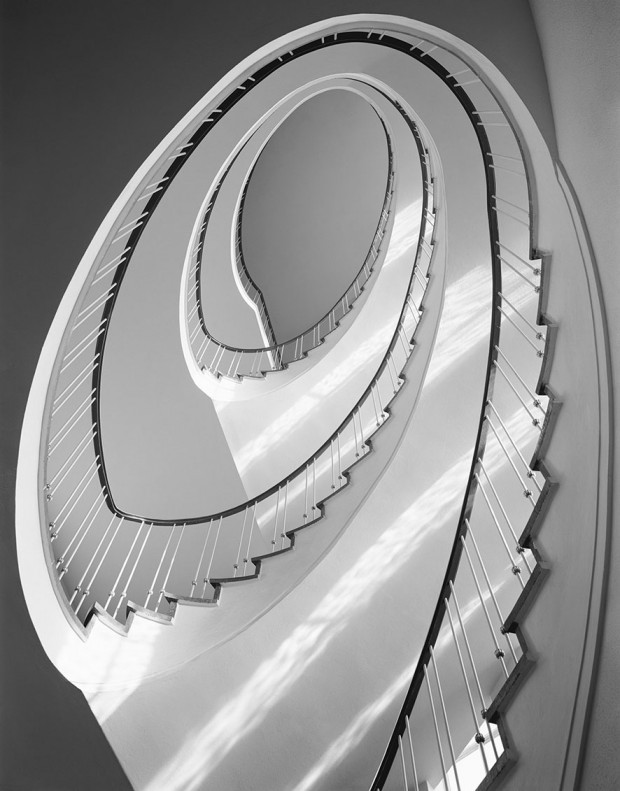An iconographic and text archive related to communication, technology and art.
☛ Karl Hugo Schmölz – Köln. Architekturfotografien der Fünfziger Jahre, with texts Ulf Erdmann Ziegler & Franz van der Grinten, published by Schirmer/Mosel, 2012 (press release). Photo: Siemenshaus, Bielefeld, Treppenhaus, 1956. Large format retrieved from der architekt.
As of 2013, there isn’t much information available in English about German architectural photographer Karl Hugo Schmölz. I couldn’t find a book translated nor a Wikipedia entry (although there is one in German), no articles from English scholars, and very few references came out through a search in Google Books. Here’s what I could gather from various sources (more references at the end).
Karl Hugo Schmölz (1917-1986) was the son of Hugo Schmölz, himself a well established German architectural photographer. Karl Hugo Schmölz learned most of his craft from his father while living in Cologne and took after his father’s business when he dies in 1938.
After the war he documented the devastation of Cologne adopting a method that is often described as “neutral” or “objective”. He took a special interest in photographing the destroyed Cologne Cathedral using a 18 x 24″ large format camera (those photos were published in a book in 1947, see below).
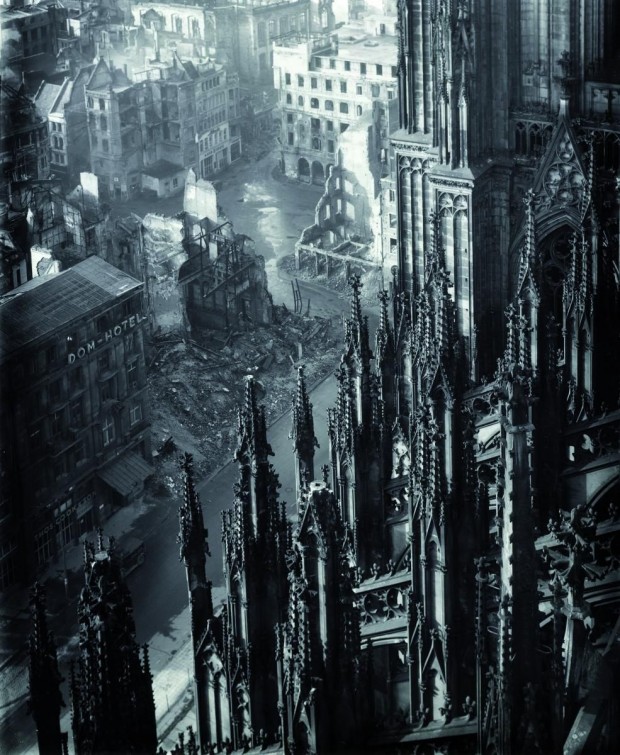
Later, in collaboration with Rhineland architects, he documented the reconstruction of the city using the same equipement (large format cameras) and technic. For this reason, his work is associated with the tradition of the “New Objectivity” (Neue Sachlichkeit):
An abrupt break occured in European photography after 1920, away from the previously predominant direction of so-called art photography. This took the form of a final departure from a style aiming at pictoresque effects and seeking to imitate post-Impressionist painting by means of soft-focus lenses and the bromoil process. The important prerequisites for the emergence of a Neue Sachlichkeit direction in photography were the development of a visual approach to things that presented its subjects in sharp detail and isolated the figures and object, bound up with the new fascination in aesthetic aspects of technology and the possibilities of scientific documentation that photography offered. (New Objectivity. Neue Sachlichkeit ― Painting in Germany in the 1920s by Sergiusz Michalski, Cologne: Taschen, [1994] 2003, p. 181)
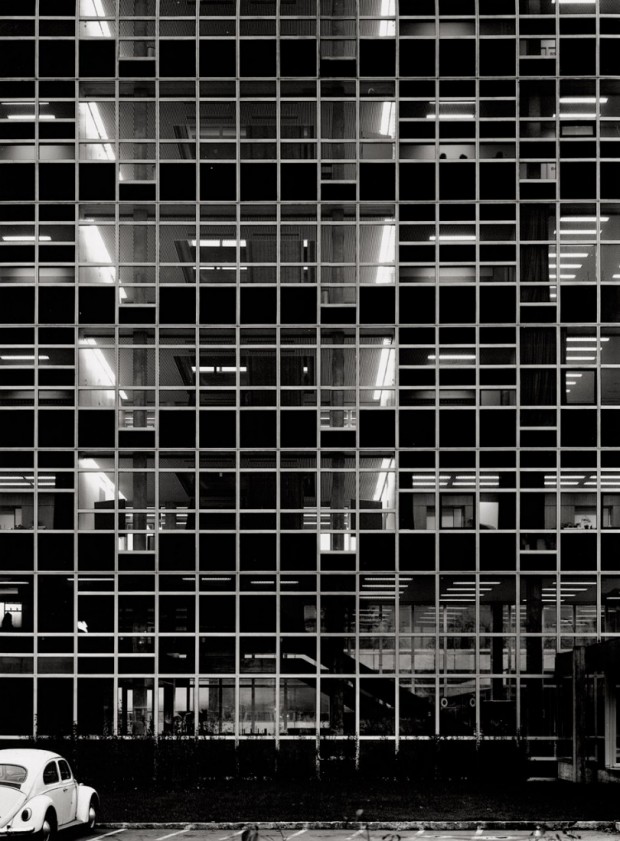
In Germany, the “New Objectivity” movement is most often associated with the work of Albert Renger-Patzsch and August Sander. Later, in the second half of the twentieth century, the movement will become famously associated with the artistic practice of German photographers Bernd and Hilla Becher. In the United-States, similar methods were explored by Edward Weston and Ansel Adams, developer of the “zone system” (see Wikipedia).
In 1929, Walter Petry published Bindung an die Dinge (Attachment to Things) which Sergiusz Michalski considers to be “the most important manifesto of Neue Sachlichkeit”. In it, he described what kind of relation the photographer should seek with the object he’s trying to capture. It applies quite well to the work of Karl Hugo Schmölz:
“The object, clearly recorded, reproduced without any artistic transformation, must communicate with its meaning exclusively the objective meaning of its self, in so far as its reproduction gets beyond the reproductive element of a flat black-and-white suggestion of nature.” (quoted in Michalski’s New Objectivity, Cologne: Taschen, [1994] 2003, p. 182)
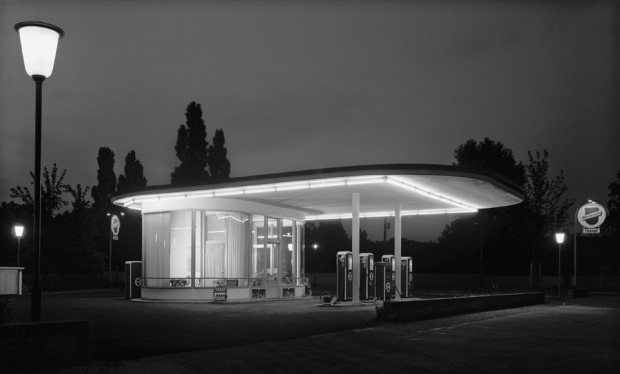
In 1956 Karl Hugo Schmölz married Walde Huth (1923-2011), herself a photographer. Two years later they founded a studio of advertising and public relation named “schmölz + huth” which received commission for advertisements, as well as from the furniture and the fashion industries:
As an architectural photographer, Schmölz possessed an eye for environment and light. Huth, a former fashion photographer, took care of composition. From the beginning the ambitious furniture industry and trendsetting furniture houses were among the most important customers. To give this current trend maximum freedom for expansion and development, schmölz + huth worked with minimalism. (read more at Lumas.com)
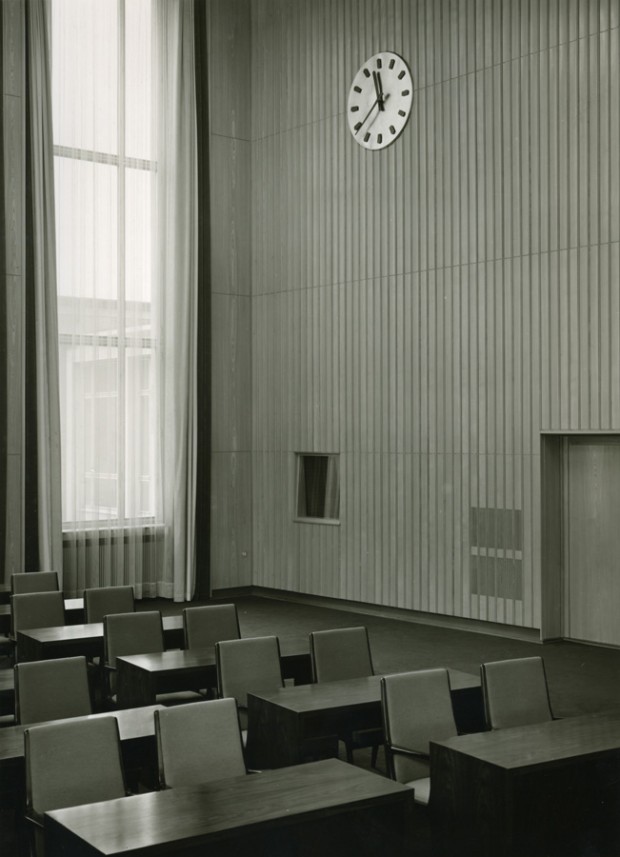
To my knowledge, there are at least three books in German about Karl Hugo Schmölz work. The first one is the book about the Cologne Cathedral first published in 1947: Dom-Ansichten: Fotografien des Kölner Doms von Karl Hugo Schmölz, 1939-1962. Used copies of a 1997 reedition are available online at a very reasonable price.
There’s also Köln-Ansichten : Fotografien von Karl Hugo Schmölz 1947-1985 edited by R. Mißelbeck and W. Hagspiel (Cologne 1999, ill. 68 pages). Used copies are also available online at the time of writing (see for example booklooker).
The most recent one is titled Karl Hugo Schmölz ― Köln. Architekturfotografien der Fünfziger Jahre (Karl Hugo Schmölz ― Cologne. Architectural photography of the fifties). It was edited by the Van Grinten Der Galerie (in Cologne) with texts by Ulf Erdmann Ziegler and Franz van der Grinten and published by Schirmer/Mosel in 2012 (official press release: PDF):
In cooperation with major Rhineland architects of the 1950s and marked by an adamant sense of style rising from a sea of rubble, Schmölz created a stunning photographic documentation of post-war architecture in Cologne. This book presents a representative selection of architectural pictures, interiors, and night views. (Schirmer/Mosel)
This publication appeared alongside the first major exhibition dedicated to Karl Hugo Schmölz. Titled Wie sich Deutschland neu erfand (How Germany reinvented), it was first held by the LVR-LandesMuseum in Bonn from September 6 to October 28, 2012, before moving to Van Grinten Der Galerie were it stays until December 15 of the same year.
Many of Karl Hugo Schmölz’s black-and-white photos available online either come from the book on the Cologne Cathedral, from the press release of Köln. Architekturfotografien der Fünfziger Jahre (11 balck&white photos with proper identification) or from the Van Grinten Der Galerie website (12 balck&white photos with proper identification; Van Grinten Der Galerie is also the official representative for Karl Hugo Schmölz’s work). Large format images from the later seem to originate from the blog post “Karl Hugo Schmölz bei Van der Grinten Galerie” published by Damian Zimmermann on October 30, 2012.
In 1999/2000, the Rhenisch Image Archive of Cologne (Rheinisches Bildarchiv Köln) acquired from the personal archive of Karl Hugo Schmölz approximately 2,000 glass and film negatives (mainly in the 18 x 24″ format) as well as a couple of large format prints. The photographs are in the process of being archived in an appropriate database. Only two images are currently displayed (read more, in German).
For more information about Karl Hugo Schmölz and the “New Objectivity” movement, consider the following resources:
-
Hugo Schmolz, fotografierte Architektur, 1924-1937 is a book about the architectural photography of Karl Hugo Schmölz’s father (München: Mahnert-Lueg, 1982). Used copies can still be bought online.
-
A review (in German) of the 2012 Wie sich Deutschland neu erfand exhibition at Frankfurter Allgemeine Zeitung: “Wir sind wieder wer und bauen nicht mehr schwer” by Andreas Rossman, October 7, 2012.
-
Invaluable, an auction website, has 61 photos by Karl Hugo Schmölz on display at the time of writing. Most are not viewable in a large format and a lot of them are heavily watermarked. However, they are all accompanied with proper identification: title, date and description. Very useful to identify a photograph or do research.
-
Camera Constructs: Photography, Architecture and the Modern City edited by Andrew Higgott and Timothy Wray, Ashgate Publishing, Ltd., 2012, pp. 82-83.
For the “New Objectivity” tradition of photography, see the following references:
-
Creative Photography: Aesthetic Trends, 1839-1960 by Helmut Gernsheim, Courier Dover Publications, [1962] 1991, specifically chapter XVIII, pp. 172-189 (Google Books with preview).
-
The Canvas and the Camera in Weimar Germany: A New Objectivity in Painting and Photography of the 1920s by Kreinik, Juliana D., Ph.D., New York University, 2008. Preview available through Google Books.
-
From the Encyclopædia Britannica: the “New Objectivity” section from the article about the “history of photography”.
Finally, an elegant portrait of a sometimes neglected space in the movie theater: the back wall with its projection window.
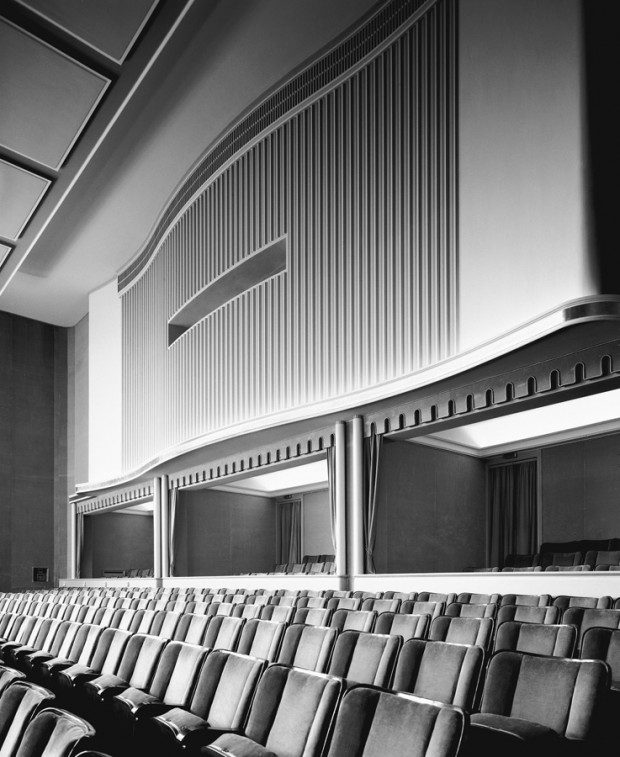
- By Philippe Theophanidis
- on
- ― Published in Architecture, Art, Photography
- Tagged: absence, building, city, Cologne Cathedral, emptiness, Germany, Karl Hugo Schmölz, new objectivity

